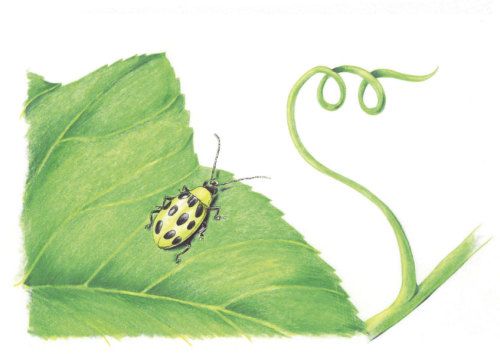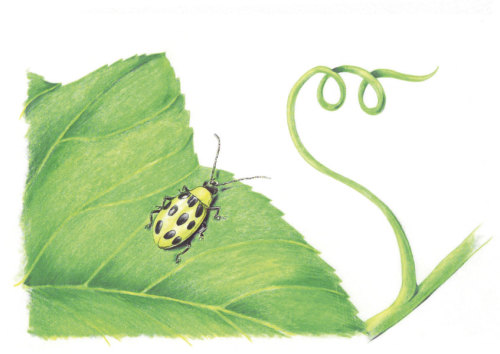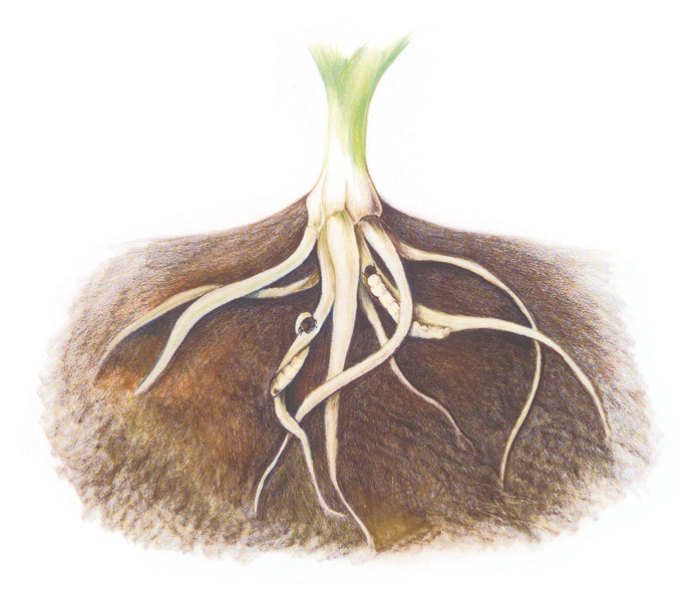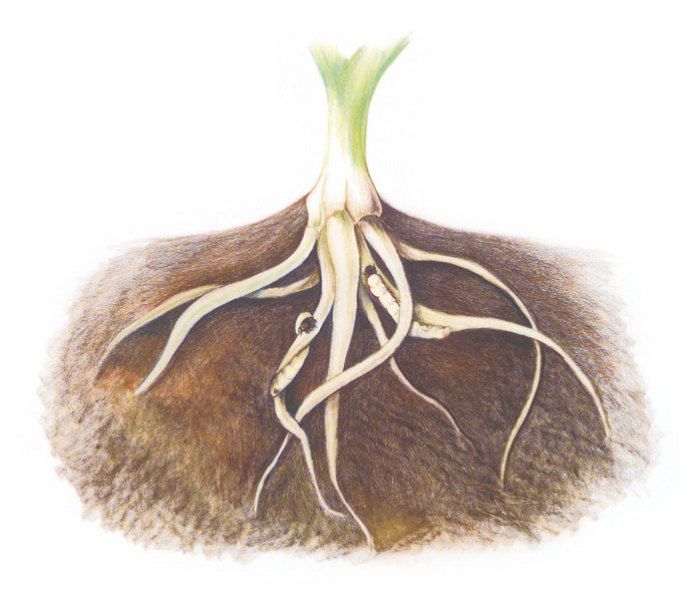
Diabrotica, rootworm, corn rootworm, striped cucumber beetle, spotted cucumber beetle, or just plain cucumber beetle—no matter what you call them, these flashy, striped or spotted beetles and their larvae are double trouble.
Adult cucumber beetles attack primarily the blossoms of corn, cucurbits (summer and winter squashes, melons, pumpkins, and cucumbers), sweet potatoes, and the leaves of legumes.
Cucumber beetles lay their eggs in the ground; their larvae live in the soil, feeding upon roots, which is why the larvae are known as rootworms. The corn rootworm probably causes more agricultural loss than any other pest, and more insecticide is used against it than against any other. Nevertheless, the sight of cucumber beetles flitting about the garden is not always a signal that disaster is on the way.

Although cucumber beetles are common every year, their damage tends to be severe only some years. Heavy populations feed mainly on cucurbit blossoms, so if you have a surplus of squash—and who doesn’t?—this might not be a problem. And not all squashes are equally susceptible to cucumber beetles in all areas.
Row covers, trap crops, and hand-picking work best to stop the adult beetle. For the larva, try beneficial nematodes.
Trap and vacuum
Farmers sometimes plant a “trap crop.” Later, they plant beside the trap the crop they mean to harvest. When the beetles settle heavily on the trap crop, they can be vacuumed off, picked off, or sprayed, thus confining the insecticide to the trap crop and not the food crop.

Some flowers, such as yellow and orange zinnias, make fine cuke beetle traps. We use a canister rug vacuum on a long extension cord grounded for outdoor use, and vacuum when temperatures are cool, and the cuke beetles are moving slowly.
The cool of the morning or evening is also the best time to hand-pick. We drown captured beetles in a wide-mouthed pot filled with a strong detergent and water solution, then compost them. The slightest jiggle of the plant will cause the beetles to drop headlong into the water.
Because seedlings are the most vulnerable to cucumber beetles, plastic or floating row covers, if carefully sealed with earth around the edges, can prevent the beetles from decimating new plantings. Row covers cannot be left on for the life of a cucurbit crop, however, because squashes and their kin depend on insects for pollination. If no insects can get through the barrier, there will be no fruit. Be sure to remove the row cover at the first sign of female flowers, recognizable by the swelling behind the blossom.
Since cucumber beetles are so obviously attracted to bright yellow, you may wonder why we’re not recommending yellow plastic sticky traps of the sort that catch whiteflies so well in the greenhouse. We have used these traps to catch cucumber beetles in the fields of organic farmers in central California. To our dismay, the traps also attracted many beneficial insects. This is not a good trade-off in the kitchen garden, so avoid sticky traps.
Bring on the nematodes
Any insect that spends part of its life cycle in the soil, as the cucumber beetle does, can usually be killed by insect-attacking nematodes. These tiny, mostly microscopic roundworms are available through catalogs and some plant nurseries.
Using such “predatory” nematodes makes sense in warm-winter areas where cucumber beetles have more than one generation per season and are likely to have larvae in the soil beneath the plants you are trying to protect. The nematodes should be applied to the earth around stem areas suspected of harboring cuke beetle larvae.
There is no effective pesticide against cucumber beetle adults available for the home garden, so learning to tolerate a little damage is probably the bottom line with these bright and shining flyers.
by William Olkowski from Kitchen Gardener, Issue #21


















Comments
Log in or create an account to post a comment.
Sign up Log in